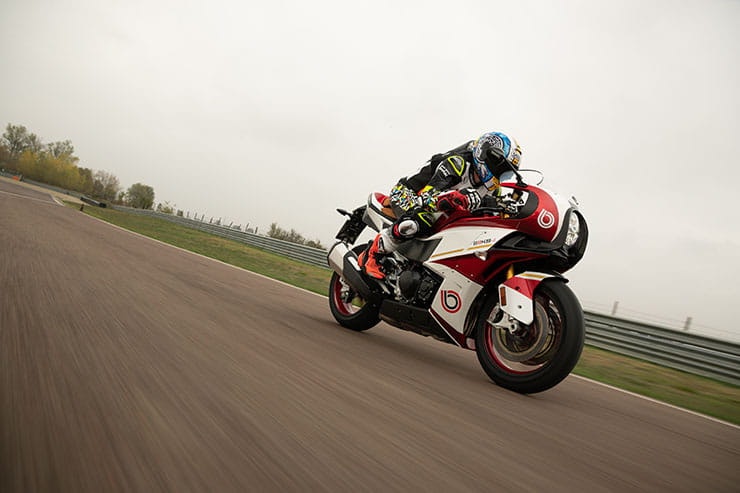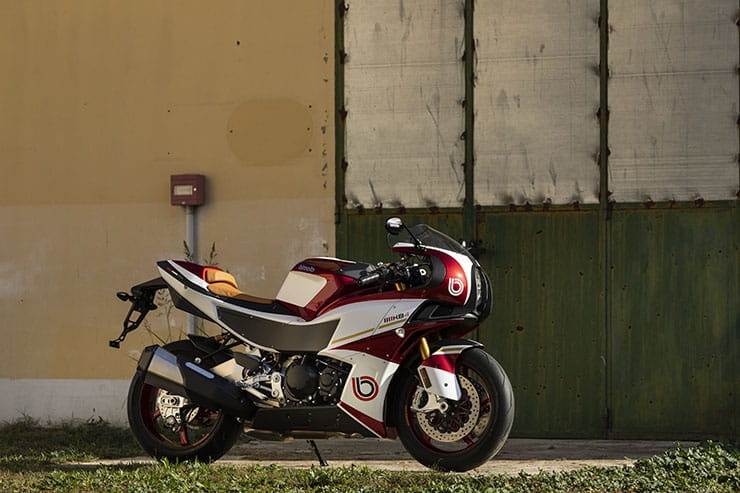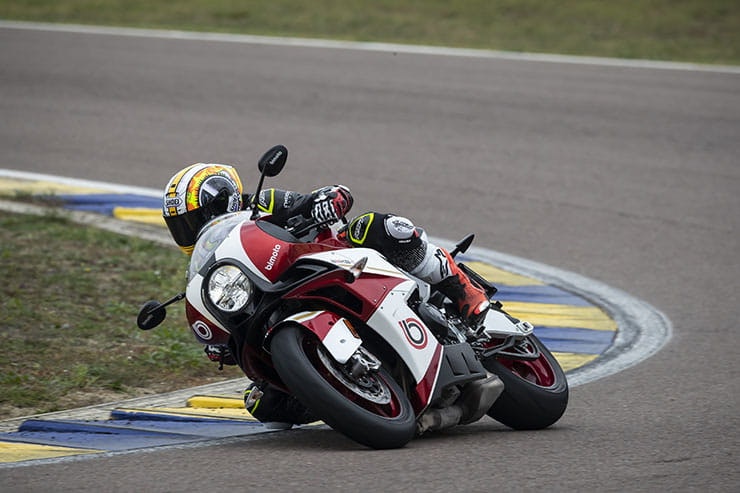Bimota KB4 (2023) - Review
BikeSocial Road Tester
28.11.2022
Price: £30,000 | Power: 140bhp | Weight: 194kg | Overall BikeSocial Rating: 5/5
Back in pre-Covid 2019, Japanese giant Kawasaki bought a 49.9% stake in Italian chassis specialists Bimota – and this, the KB4, follows the £60,000 TESI H2 to become the second model to emanate from their burgeoning partnership.
It’s nothing new for Bimota to use Kawasaki engines – the first time was the Z-powered KB1 way back in 1977 – so it feels quite natural that the KB4 is built around a Kawasaki inline four; fitting, too, that its retro look and ‘liquid red’ paint act as evocative tributes the now highly collectible early KB (for Kawasaki and Bimota) machines.
Today’s relationship with Kawasaki is, however, very different from that of yesteryear. Since the 2019 deal was struck Bimota has had access to the Japanese manufacturer's 's range of engines and ancillaries. Not only is the K4's engine from Kawasaki, but so also are the electronic rider aids, fuelling system, exhaust, air-box, switchgear, clocks and headlight even (stolen, in case you hadn't worked it out for yourself, from the Z900).
That means huge development-cost savings for Bimota, who are now free to pull fully tested, proven and homologated parts from the Kawasaki shelf, and focus on what they do best: designing and building sublime rolling chassis.
The KB4 frame is all Bimota and uses the Kawasaki 1000SX engine as a stressed member. An aluminium swing-arm bolts directly to the engine via a machined mounting plate. At the front, a steel trellis support bolts to the Japanese motor, and holds the fully adjustable Öhlins NIX30 forks. Bimota wanted a short wheelbase, shorter than a Kawasaki ZX-6R, which means the engine is positioned as far forward as possible with the radiator mounted under the seat unit as there wasn’t room between the front wheel and traditional radiator position. The rad is fed cooling air via two unmissable carbon air scoops that run along both sides of the bike.
Bimota claims the KB4 is a sports tourer but elected to let us loose around the tight and demanding Modena racetrack in Northern Italy, just a stone’s throw from the Ferrari factory. This may be sports touring, but not as we have seen before.
Unique design and exclusivity
Lightness and handling like a 600cc supersport
The sportiest sports tourer on the market
30 grand is a big pile of cash
Limited ground clearance on track
No pillion seat on a sports tourer
Review: 2023 Bimota KB4
Just how sporty can a sports-tourer be? Bimota’s KB4 is probably the closest machine out there so we sent Adam ‘Chad’ Child to give it a ride.
2023 Bimota KB4 Price
How much is the Bimota KB4? £30,000
As you would expect given its exclusivity and high-spec design and parts, the KB4 isn’t cheap. £30,000 is more than double the price of Kawasaki’s Ninja 1000SX £12,349, on which it is loosely based. Bimota claims this is a sports tourer, despite not having the facilities to carry a pillion, and for much less than £30,000 there are some sporty sports tourers out there. Aprilia’s V4 Tuono is £14,850 while Ducati’s Supersport 950S is ‘only’ £15,795. Yes, the Bimota is sporty, but you could buy both a Ninja 1000SX for touring and a ZX-10R (£17,499) for sporty days and still have some change from £30k.
That said, if you are looking for the exclusivity and kudos a Bimota can bring and are also concerned about the budget, you’re looking in the wrong area. The KB4 is very individual, awash with quality components and carbon fibre while rocking a design unlike any other bike on the planet. One glance at its real leather seat, Brembo stoppers, forged Oz wheels and Öhlins suspension tells you all you need to know about its premium pricing.
2023 Bimota KB4 Power and torque
The 1043cc motor is taken directly from Kawasaki’s popular Ninja 1000SX, which was updated in 2020. This means that power and torque are the same as the Kawa. If the Italians had changed any aspect of the engine, it would have proved costly and time-consuming as they would have had to go through the process of Euro-5 homologation once more, meaning ancillaries like the fuelling system and exhaust are as found on the SX too – proven and reliable.
Peak power is 104.5 kW/140bhp @ 10,000rpm and peak torque is 111Nm /81.7 ft.lbs @ 8000rpm. All the hard work has already been done by Kawasaki, already Euro-5, with proven reliability and excellent fuelling.
Engine, gearbox, and exhaust
Kawasaki’s 1000SX has always been one of the sportiest of sports tourers. I’ve ridden every model since its press introduction in 2010 and covered 20,000 miles on a 2014 machine. The motor defines the SX; it has oodles of lovely torque, smooth fuelling and is easy to get along with. However, as I rode out of pitlane on my Bimota 1000SX, I was a little unsure how it would translate in the KB4's short and sporty chassis.
I needn't have worried. During the first few laps, while getting familiar with the bike and track, there was no need to dance up and down on the quick shifter; instead the SX's surging torque drove the KB4 between corners, unconcerned whether it was second or third gear. The fuelling was super smooth, too, and just as SX fans have come to love. The KB4 felt relaxed and as easy to ride on the track as the Kawasaki SX is in the Alps. Anyone who is new to track riding will love the undemanding style of the KB4.
Come session two, I really wanted to know if the Kawa power could thrill on track when pushed harder. With Sports mode (one of four riding modes) selected and the lean-sensitive rider aids reduced, it was time to have some fun. Quoted power is 140bhp and dry weight is just 189kg, figures that place the KB4 not a million miles away from Suzuki’s legendary, 148bhp GSX-R750, but the Bimota has more torque and is far easier to hustle despite being a little heavier.
In fact, the tight and twisty Modena track favoured the high-torque and relatively slow revving nature of the Bimota. In today’s world you supposedly need 200bhp to be a trackday superstar but the KB4's 140bhp was more than enough for me.
Even when I put the hammer down around the Ferrari test track, I never wanted for horses. I’ll take a smooth, linear power delivery and perfect throttle response over a few more bhp at the top of the tacho, any day of the week. At some fast tracks, like Silverstone, it may feel underpowered against full-blown superbikes, but on the road it should prove to be a lovely balance of power and torque. Just a shame it sounds a little muted.
Handling, suspension, and weight
It may look like a designers' dream but the KB4 was, first and foremost, designed by clever chassis engineers, then passed to the style department who were then asked to add some Italian flair.
Primarily, Bimota wanted to ensure the connection between the bike and the rider is direct and absolute. To achieve this the machined swingarm is bolted directly to the back of the engine. At the front is a steel trellis support that holds the fully adjustable Öhlins forks, while the engine is used as a stressed member.
Bimota knew what they wanted to achieve to make the bike handle, too. They wanted a short wheelbase but a long swing arm to achieve the perfect front: ear weight distribution. The engine is positioned as far forward as possible to give a fast and feisty weight distribution of 53.6% front and 46.4% rear. This meant there was no room for a radiator, which is why it was positioned under the seat unit and supplied cooling air via huge carbon ducts on both sides of the bike.
The result of the chassis engineers’ hard work is a short 1390mm wheelbase that's much shorter than the Ninja 1000SX (1440mm) even shorter than a ZX-6R (1390mm), offset by a long swing-arm. Bodywork is mainly carbon fibre, and the lack of conventional frame reduces dry weight to just 189kg.
It’s a little confusing when comparing weights because Kawasaki’s 636cc ZX-6R has a (fully fuelled) kerb weight of 196kg while the 1000SX's kerb weight is 235kg. Bimota does quote a fuelled weight of 194kg but with the tank just one-quarter filled. Dry weight, meanwhile, is at 189kg... So, I would estimate that, fully fuelled, the KB4 would be around 200kg.
Thankfully, I don’t need a spec-sheet to tell the KB4 is a genuine lightweight. On the move it feels incredibly agile, making light work of Modena's scratchy second and third-gear corners. It’s a little strange as the 'sports tourer' riding position is relatively relaxed even though the chassis geometry is as sharply focused – ready to turn and turn fast – as many pure sportsbike's. It ate up Modena's hairpins.
The tight switch-back sections mid-way through the lap highlighted the easy fluidity of the KB4. Kawasaki’s Ninja 1000SX isn’t a bad handling bike but the Italian chassis is on another level. The KB4 is more comparable to a ZX-6R or GSX-R750 in terms of handling, but with a more relaxed riding position and ‘soft’ motor.
Chassis and tyres (Pirelli Supercorsa Evo) generate heaps of forensic-level grip and build enormous confidence in the rider, too. Brake ever later and deeper and there’s no complaint. Get on the power sooner than you thought possible, and the Bimota simply drives forward without fuss. Once, at elbow dragging levels of lean, the exhaust made a painful and expensive sound as it dragged on the track and did so before the (adjustable) footpegs touched the surface.
The K4 is ultra-adjustable and with the ride height increased, ground clearance was improved to the point that the exhaust only tickled the track on the very odd occasion (and there's also an optional silencer available that is less bulky tan the Kawasaki original saving 2kg). However, I’m a reasonably light 80kg, and ground clearance might become more of a limiting issue for a heavier riders on a quick lap.
That said, clearance is far better on stock settings than a Ninja 1000SX, and I was riding on my limit, pushing for a lap time, and occasionally dragging my elbow. That is what is so impressive about the K4; like so many of its predecessors it has inherently racy genes that make it easy to ride, even when pushing hard. There’s such a strong connection between brain and tyre contact patch – such a positive feeling – that I never missed an apex all day.
The Bimota chassis is predictable, stable, accurate and light, and perfectly matched the usable power of the SX engine.
2023 Bimota KB4 Comfort and economy
Unfortunately, we didn’t get the opportunity to ride on the road, but some of the excellent qualities of the Kawasaki 1000SX should carry over to the Bimota. The KB4 shares its engine and 19.5-litre fuel tank so in theory mpg and fuel range should be about the same. Kawasaki quote 5.8/100km/49mpg and the Bimota should return around the same, possibly better as it’s lighter.
Like the SX, cruise control comes as standard. The SX's 4.3-inch TFT dash, updated in 2020, is adopted too along with the Kawsaki's easy-to-use switchgear and rider aids, which include a Rain mode and lower power mode for those very few who might ride the Bimota in the wet.
The Bimota doesn’t have the adjustable screen and wind protection of the SX, and panniers are not an option. In fact, you can’t even add a pillion, and Bimota don’t offer any touring accessories. But the Bimota does have multi-adjustable quality Öhlins suspension, and the pegs are adjustable.
I found the real leather seat a little snug as the seat hump rather close and you’re up against the tank, but the riding position is natural and genuinely sports-touring in stance. I imagine the light handling, quality suspension and brakes will work well on the road but suspect it won't be as comfortable as the SX. Riding all day should be do-able, though, and the prospect of tackling the mountain passes of the Italian Alps is truly mouth-watering.
Brakes
Lean-sensitive ABS is carried over from Kawasaki but recalibrated due to the lightness of the Bimota. The KB4 uses larger 320mm diameter discs, 20mm larger than the Kawasaki, plus racy Brembo Stylema radial stoppers, not the SX's Tokico items.
Performance is impressive, but this is also due to the feeling of the Öhlins front end and the lightness of the chassis. It’s not at the level of stopping found on high-end sportsbikes but not far off it. On track, the ABS is a little too intrusive, but for a sports tourer, possibly has market-leading stopping power. It certainly hauls up quicker than the Ninja 1000SX.
Rider aids, extra equipment, and accessories
Rider aids are carried over from the SX but as mentioned recalibrated for the Bimota’s lack of weight and handling. These are: Kawasaki Cornering Management Function (KCMF) and Kawasaki Traction Control (KTRC), with three levels and a deactivation option. Kawasaki Intelligent anti-lock Brake System (KIBS) and ABS are present and correct along with power modes 'full' and 'low', low offering 75%-80% of maximum power, and four riding modes: Sport, Road, Rain and a personalised mode. The Dual-direction Kawasaki Quick Shifter (KQS) also comes as standard. All rider aids are lean-sensitive and linked to a six-axis IMU.
Despite the price, Bimota hasn’t added any extra rider aids beyond the Kawasaki package. No launch control, or engine braking strategy for example. And as mentioned earlier, Bimota doesn’t offer any touring accessories, not even pillion pegs, so pillions will have to take the bus.
Bimota KB4 Rivals
Despite being billed as a sports-tourer, the KB4 is, of course, nothing of the sort. A short wheelbase, and neither a pillion seat nor pegs would back that up. Nevertheless, here’s a few alternatives to consider if the KB4 made your shortlist:
Kawasaki Ninja 1000SX | Price: £12,349
Power/Torque: 104kw/139 bhp / 111 Nm/ 81.9 lb-ft | Weight: 235kg
Ducati Supersport 950S | Price: £15,795
Power/Torque: 81kw/110 bhp / 93 Nm/ 69 lb-ft | Weight: 184kg (dry)
Aprilia TuonoV4 | Price: £14,800
Power/Torque: 129kw/173 bhp / 121 Nm/ 89 lb-ft | Weight: 209kg
Bimota KB4 - Verdict
The KB4's unusual looks seem to divide opinion. I was unsure when I first saw it in pictures but now I’ve seen it in the flesh and witnessed the engineering and quality finish up close, I have grown to like it. It’s certainly different and bold, and it looks like a £30,000 bike. The engineering and attention to detail are to be applauded.
Dynamically, there's a lot to praise. The handling is light and easy, it works superbly on track, and should transfer its easy ability to the road. It’s fun to ride – anything but overwhelming – and the chassis and suspension transmit masses of feel and security to the rider. That smooth and torquey Kawasaki 1000SX motor feels completely at home in the Bimota, too.
At times on the track, it was all too easy to think of the KB4 as an all-out sports bike, but the riding position is relatively relaxed, and it hasn’t just been designed to work on track. It will be interesting to see if this new "sports tourer" is as good at touring as it is at sports riding.
The only downside is the £30,000 price. There are cheaper, faster and possibly comfier alternatives with smarter electronic technology like the Aprilia Tuono V4. But the competition can’t match the exclusivity and desirability of the KB4.
2023 Bimota KB4 Technical Specification
Looking for motorbike insurance? Get a quote for this bike with Bennetts motorcycle insurance
What is MCIA Secured?
MCIA Secured gives bike buyers the chance to see just how much work a manufacturer has put into making their new investment as resistant to theft as possible.
As we all know, the more security you use, the less chance there is of your bike being stolen. In fact, based on research by Bennetts, using a disc lock makes your machine three times less likely to be stolen, while heavy duty kit can make it less likely to be stolen than a car. For reviews of the best security products, click here.
MCIA Secured gives motorcycles a rating out of five stars, based on the following being fitted to a new bike as standard:
A steering lock that meets the UNECE 62 standard
An ignition immobiliser system
A vehicle marking system
An alarm system
A vehicle tracking system with subscription.
The higher the star rating, the better the security, so always ask your dealer what rating your bike has, and compare it to other machines on your shortlist.


